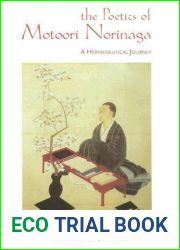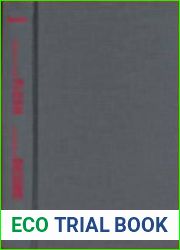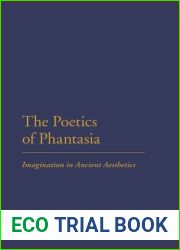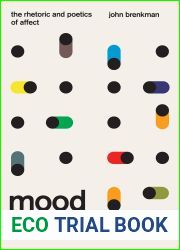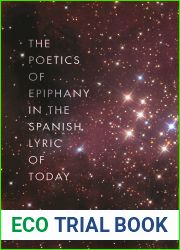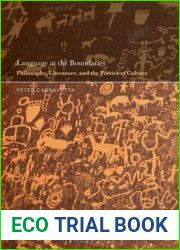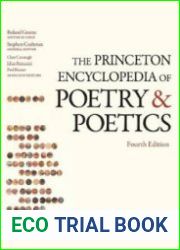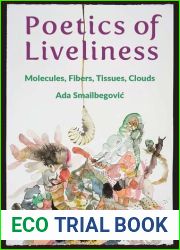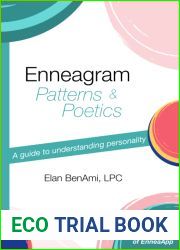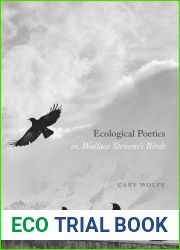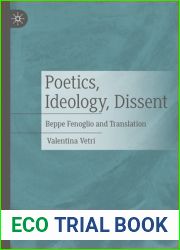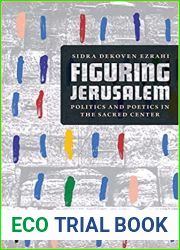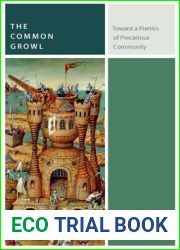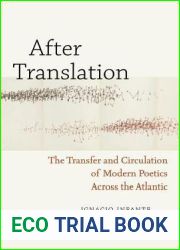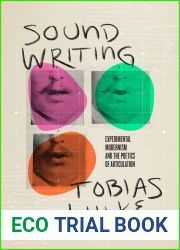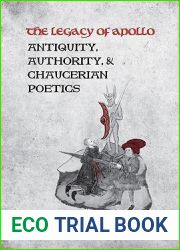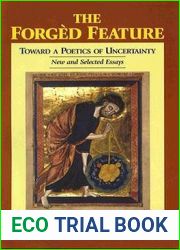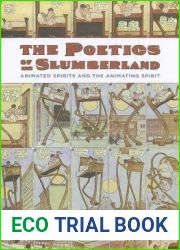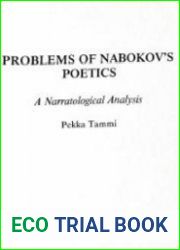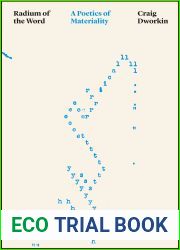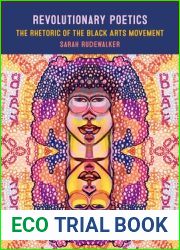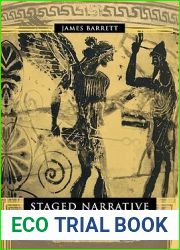
BOOKS - The Poetics of Motoori Norinaga: A Hermeneutical Journey

The Poetics of Motoori Norinaga: A Hermeneutical Journey
Author: Michael F. Marra
Year: May 1, 2007
Format: PDF
File size: PDF 948 KB
Language: English

Year: May 1, 2007
Format: PDF
File size: PDF 948 KB
Language: English

The Poetics of Motoori Norinaga: A Hermeneutical Journey Motoori Norinaga, one of Japan's most celebrated intellectuals, is widely recognized for his concept of "mono no aware a detailed description of the workings of emotions as the precondition for the poetic act. As a poet and theorist of poetry, Norinaga had an acute eye for etymologies and other archaeological practices aimed at uncovering the depth and richness of the Japanese language. This book contains his major works on the Yamato region, the heartland of Japanese culture, including his famous poetic diary, "The Sedge Hat Diary translated into English for the first time. Written in 1772 during Norinaga's journey through Yamato and the Yoshino area, "The Sedge Hat Diary" is composed in the style of Heian prose and interspersed with fifty-five poems. It offers profound insights into Norinaga the poet, scholar of ancient texts, devout believer in Shinto deities, and archaeologist searching for traces of ancient capitals, palaces, shrines, and imperial tombs of the pre-Nara period. In this piece, Norinaga presents Yoshino as a common poetic space, inviting readers to inhabit it and develop a shared sense and ethical living in the poet's ideal society. Norinaga's ideal society is deeply imbued with the knowledge of poetry and understanding of emotions, as evident in the translation of his twenty-six songs on aware pathos also included here.
Поэтика Мотоори Норинаги: Герменевтическое путешествие Мотоори Норинага, один из самых известных интеллектуалов Японии, широко известен своей концепцией «mono no aware» подробное описание работы эмоций как предварительного условия для поэтического акта.Как поэт и теоретик поэзии, Норинага имел острый глаз для этимологий и других археологических практик, направленных на раскрытие глубины и богатства японского языка. Эта книга содержит его основные работы о регионе Ямато, сердце японской культуры, в том числе его знаменитый поэтический дневник «Дневник осоковой шляпы», впервые переведенный на английский язык. Написанный в 1772 году во время путешествия Норинаги по Ямато и району Ёсино, «Дневник осоковой шляпы» составлен в стиле хэйанской прозы и перемежается с пятьюдесятью пятью стихотворениями. Он предлагает глубокое понимание Норинаги, поэта, исследователя древних текстов, набожного верующего в синтоистские божества и археолога, ищущего следы древних столиц, дворцов, святынь и императорских гробниц периода до Нара. В этом произведении Норинага представляет Ёсино как общее поэтическое пространство, предлагая читателям населить его и развивать общий смысл и этическую жизнь в идеальном обществе поэта. Идеальное общество Норинаги глубоко проникнуто познанием поэзии и пониманием эмоций, что видно в переводе его двадцати шести песен на осознанном пафосе, также вошедших сюда.
Motoori Norinaga Poetica : voyage herméneutique de Motoori Norinaga, l'un des intellectuels les plus célèbres du Japon, est largement connu pour son concept de « mono no aware » description détaillée du travail des émotions comme condition préalable à l'acte poétique. En tant que poète et théoricien de la poésie, Norinaga avait un œil aigu pour les étymologies et autres pratiques archéologiques visant à révéler la profondeur et la richesse de la langue japonaise. Ce livre contient ses principales œuvres sur la région de Yamato, le cœur de la culture japonaise, y compris son célèbre journal poétique « journal du chapeau de guêpe », traduit pour la première fois en anglais. Écrit en 1772 lors du voyage de Norinaga à Yamato et dans la région de Yoshino, « journal du chapeau de guêpe » est composé dans le style de la prose de Heian et est entrecoupé de cinq poèmes. Il offre une compréhension approfondie de Norinaga, un poète, un chercheur de textes anciens, un pieux croyant aux divinités shintoïstes et un archéologue qui cherche des traces d'anciennes capitales, palais, sanctuaires et tombes impériales de l'époque avant Nara. Dans cette œuvre, Norinaga présente Yoshino comme un espace poétique commun, invitant les lecteurs à l'habiter et à développer un sens commun et une vie éthique dans la société idéale du poète. La société idéale de Norinaga est profondément imprégnée de la connaissance de la poésie et de la compréhension des émotions, comme le montre la traduction de ses vingt-six chansons sur un pathos conscient qui est également entré ici.
Poética de Motori Norinagi: viaje hermenéutico de Motoori Norinaga, uno de los intelectuales más famosos de Japón, es ampliamente conocido por su concepto de «mono no aware» una descripción detallada del trabajo de las emociones como condición previa para un acto poético. Como poeta y teórico de la poesía, Norinaga tenía un ojo agudo para las etimologías y otras prácticas arqueológicas destinadas a revelar la profundidad y riqueza del idioma japonés. Este libro contiene sus principales obras sobre la región de Yamato, corazón de la cultura japonesa, incluyendo su famoso diario poético «Diario de sombrero de avispa», traducido por primera vez al inglés. Escrito en 1772 durante el viaje de Norinaga por Yamato y el distrito de Yoshino, el «Diario del sombrero de avispa» está compuesto en estilo prosa heiana e intercalado con cincuenta y cinco poemas. Ofrece una profunda comprensión de Norinaga, poeta, explorador de textos antiguos, devoto creyente de las deidades sintoístas y arqueólogo que busca las huellas de las antiguas capitales, palacios, santuarios y tumbas imperiales del período anterior a Nara. En esta obra Norinaga presenta a Yoshino como un espacio poético común, invitando a los lectores a habitarlo y desarrollar un sentido común y una vida ética en la sociedad ideal del poeta. La sociedad ideal de Norinaga está profundamente impregnada de conocimiento de la poesía y de comprensión de las emociones, como se puede ver en la traducción de sus veintiséis canciones sobre un consciente pathos que también han entrado aquí.
Poetica Motori Norinaghi: Il viaggio ermeneutico di Motori Norinaga, uno degli intellettuali più famosi del Giappone, è comunemente noto per il concetto di «mono no aware», descrizione dettagliata del funzionamento delle emozioni come condizione preliminare per un atto poetico. Come poeta e teorico della poesia, Norinaga aveva un occhio acuto per le etimologie e altre pratiche archeologiche mirate a rivelare la profondità e la ricchezza della lingua giapponese. Questo libro contiene i suoi lavori principali sulla regione di Yamato, il cuore della cultura giapponese, tra cui il suo famoso diario poetico, «Il diario del cappello della stiva», tradotto per la prima volta in inglese. Scritto nel 1772 durante il viaggio di Norinaga in Yamato e nel quartiere di Yoshino, Il diario del cappello di vescica è in stile prosa Hayana e si trasforma in cinque poesie. Offre una profonda comprensione di Norinaga, poeta, studioso di testi antichi, devoto devoto alle divinità sintoiste e archeologo che cerca tracce di antiche capitali, palazzi, santuari e tombe imperiali del periodo prima di Nar. In questa opera, Norinaga presenta Yoshino come uno spazio poetico comune, offrendo ai lettori di popolarlo e sviluppare un senso comune e una vita etica nella società ideale del poeta. La società ideale di Norinaga è profondamente invasa dalla conoscenza della poesia e dalla comprensione delle emozioni, come si vede nella traduzione delle sue ventisei canzoni su un pathos consapevole, che sono anche entrati qui.
Motoori Norinagas Poetik: Die hermeneutische Reise Motoori Norinaga, einer der bekanntesten Intellektuellen Japans, ist weithin bekannt für sein Konzept „mono no aware“, eine detaillierte Beschreibung der Arbeit von Emotionen als Voraussetzung für einen poetischen Akt. Als Dichter und Theoretiker der Poesie hatte Norinaga ein scharfes Auge für Etymologien und andere archäologische Praktiken, die darauf abzielten, die Tiefe und den Reichtum der japanischen Sprache zu enthüllen. Dieses Buch enthält seine Hauptwerke über die Yamato-Region, das Herz der japanischen Kultur, einschließlich seines berühmten poetischen Tagebuchs „Das Tagebuch des Wespenhutes“, das erstmals ins Englische übersetzt wurde. Das 1772 während Norinagas Reise durch Yamato und den Yoshino-Bezirk geschriebene „Tagebuch eines Wespenhutes“ ist im Stil der Heian-Prosa komponiert und mit fünfundfünfzig Gedichten durchsetzt. Es bietet einen tiefen Einblick in Norinaga, einen Dichter, einen Forscher antiker Texte, einen frommen Gläubigen shintoistischer Gottheiten und einen Archäologen, der nach Spuren antiker Hauptstädte, Paläste, Schreine und kaiserlicher Gräber aus der Zeit vor Nara sucht. In dieser Arbeit stellt Norinaga Yoshino als einen gemeinsamen poetischen Raum dar und lädt die ser ein, ihn zu bewohnen und einen gemeinsamen nn und ein ethisches ben in der idealen Gesellschaft des Dichters zu entwickeln. Norinagas ideale Gesellschaft ist tief durchdrungen von der Kenntnis der Poesie und dem Verständnis von Emotionen, was sich in der Übersetzung seiner sechsundzwanzig Lieder auf bewusstem Pathos zeigt, die auch hier enthalten sind.
''
Motoori Norinaga Poetics: Japonya'nın en ünlü entelektüellerinden biri olan Motoori Norinaga'nın hermeneutik yolculuğu yaygın olarak onun Şiirsel bir eylem için bir ön koşul olarak duygu çalışmalarını detaylandırmanın "mono no aware" kavramı. Bir şair ve şiir teorisyeni olarak Norinaga, Japon dilinin derinliğini ve zenginliğini açığa çıkarmayı amaçlayan etimolojiler ve diğer arkeolojik uygulamalar için keskin bir göze sahipti. Bu kitapta, Yamato bölgesi, Japon kültürünün kalbi, ünlü şiir günlüğü "The Sedge Hat Diary'de dahil olmak üzere, ilk kez İngilizce'ye çevrilen başlıca eserleri yer almaktadır. 1772'de Norinaga'nın Yamato ve Yoshino Bölgesi'ndeki yolculuğu sırasında yazılan "Diary of a Seddge Hat", Heian düzyazısı tarzında bestelendi ve elli beş şiirle serpiştirildi. Bir şair, eski metinlerin alimi, Şinto tanrılarına inanan ve Nara öncesi dönemden kalma eski başkentlerin, sarayların, türbelerin ve imparatorluk mezarlarının izlerini arayan arkeolog Norinaga hakkında derin bir anlayış sunar. Bu çalışmada Norinaga, Yoshino'yu ortak bir şiirsel alan olarak sunar ve okuyucuları şairin ideal toplumunda ortak bir anlam ve etik yaşam yaşamaya ve geliştirmeye davet eder. Norinaga'nın ideal toplumu, bilinçli pathos üzerine yirmi altı şarkısının çevirisinde görülebilen şiir bilgisi ve duyguların anlaşılmasıyla derinden doludur.
Motoori Norinaga Poetics: الرحلة التأويلية لموتوري نوريناغا، أحد أشهر المفكرين في اليابان، معروفة على نطاق واسع برحلته مفهوم «أحادي لا يدرك» لتفصيل عمل العاطفة كشرط مسبق للعمل الشعري. بصفته شاعرًا ومنظرًا شعريًا، كان نوريناغا يتطلع بشدة إلى الأصول والممارسات الأثرية الأخرى التي تهدف إلى إطلاق العنان لعمق وثراء اللغة اليابانية. يحتوي هذا الكتاب على أعماله الرئيسية حول منطقة ياماتو، قلب الثقافة اليابانية، بما في ذلك مذكراته الشعرية الشهيرة، «يوميات قبعة سيدج»، التي تُرجمت لأول مرة إلى اللغة الإنجليزية. كتبت في عام 1772 خلال رحلة نوريناغا عبر منطقة ياماتو ويوشينو، «يوميات قبعة سيدج» مؤلفة بأسلوب نثر هيان وتتخللها خمس وخمسون قصيدة. يقدم فهمًا عميقًا لنوريناغا، وهو شاعر، وباحث في النصوص القديمة، ومؤمن متدين بآلهة الشنتو، وعالم آثار يبحث عن آثار للعواصم القديمة والقصور والأضرحة والمقابر الإمبراطورية من فترة ما قبل نارا. في هذا العمل، تقدم نوريناغا يوشينو كفضاء شعري مشترك، وتدعو القراء للعيش فيه وتطوير معنى مشترك وحياة أخلاقية في المجتمع المثالي للشاعر. المجتمع المثالي في نوريناغا مشبع بعمق بمعرفة الشعر وفهم المشاعر، والتي يمكن رؤيتها في ترجمة أغانيه الستة والعشرين عن الشفقة الواعية، المدرجة هنا أيضًا.







